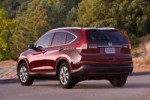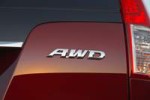Honda’s SUV Is Back On Top In Sales
It’s not easy to be the top dog of a vehicle category. Just ask Honda.
The company’s CR-V compact crossover vehicle has been battling the Ford Escape for years, and the two have traded places as the number-one seller in their category several times. CR-V won the top spot in 2012 and 2013, but slid to second place during the first quarter of 2014.
Now it’s back on top. With a strong April 2014, the CR-V claimed the title for the first time this year, and having done so, also surpassed the Escape as the year-to-date sales leader.

Among the CR-V’s assets is fuel economy. It earns inclusion in our All-Wheel Drive 30 MPG Club with an EPA estimated 30 mpg highway/22 mpg city and a combined rating of 25 mpg.
Honda also makes the CR-V easy to buy. There is only one engine, a choice of two- or all-wheel drive and three trim levels. There are only two options, navigation and rear seat entertainment, available on the top trim.
What Makes The CR-V A Crossover SUV?
The CR-V merits crossover status because it shares its platform with the Civic compact sedan. A crossover combines an SUV body style with a car-type understructure. Their one-piece construction, called “unibody,” contrasts with old-school sport utilities that are based on trucks, which attach the body to a separate frame. The body on frame construction provides the ability to tow heavy trailers and haul big loads, but typically sacrifices fuel economy.
A unibody design isn’t as suited to heavy-duty towing or hauling but its lighter weight benefits ride, handling, and fuel economy. The 2014 CR-V is rated to tow trailers weighing up to 1,500 pounds, about average for a four-cylinder compact crossover.
Standing Pat On The 2012 Redesign
The 2014 CR-V styling and interior are unchanged coming off a complete redesign for model year 2012. It is handsomely aerodynamic and rightly proportioned, if less flamboyant than the shaped-in-Europe Escape and the been-to-the-gym Toyota RAV4 (another compact crossover big seller.
Some commentators say the exterior styling is bland. I disagree. Large wheels and bold fender wells combined with sculpted side body panels give a pseudo-aggressive look. In profile, the sweeping roofline has an almost coupe-like appearance.
Plus, I like the now signature vertical taillights. Larger than the previous model, the base extends into the rear body panels in a hockey stick style, and at night you know there’s a CR-V ahead of you.
Interior room is one of the CR-V’s biggest draws, while comfort on supportive seats front and rear are another selling point. Up front, the driver has a high seating position without sacrificing headroom, and in the rear is an abundance of legroom and plenty of space for two child seats. The 60/40 split rear seats recline, but don’t move fore and aft like some competitors.
Cargo volume is vacation-worthy with 37.2 cubic feet of space behind the second row. That’s three cubes more than the Escape and about even with the RAV4.

Need more room to haul stuff? A clever mechanism folds the rear seat even with the rear load floor at the pull of a single lever or strap, expanding cargo volume to 70.9 cubic feet — more space than you’ll find in most affordable compact SUVs.
The CR-V’s dashboard is well laid-out and well organized with upper and lower display screens that show settings for Bluetooth mobile phone linking and the image from the rearview backup camera — both of which are standard. The transmission shift lever is located just right of the steering wheel, making room for a large center console between the front seats. Add eight cupholders and an ample number of storage bins, and the CR-V is a crossover that validates the “utility” in “SUV.”
Honda has fashioned an efficiently sized exterior enveloping a smartly packaged interior, but falls short on interior materials compared to the Escape and RAV4, as well as other small crossovers. Fitment is quite good with no panel gaps, however hard plastics that cover the dash and door panels may be durable, but they border on cheap looking. Plus, there is a lack of soft-touch materials in places like arm rests.
Efficient Engine But Just Adequate Oomph
The 2014 CR-V soldiers on with a dual-overhead cam 2.4-liter four-cylinder engine that features Honda’s i-VTEC “intelligent” valve control system. Its 185 horsepower is among the highest among competitors, but torque of 185 pounds feet is below the mean. Torque is the force that gets the vehicle moving and is more important to the feel of acceleration than horsepower, which is the energy that keeps the vehicle moving.
Also off the pace with rivals is CR-V’s five-speed automatic – its only transmission. Most top competitive models have an automatic with at least six speeds; the Jeep Cherokee tops others with a nine-speed automatic. In transmissions, more gears provide improved, efficient acceleration and fuel economy. On the plus side, a dashboard “Econ” button configures the CR-V’s transmission to favor fuel economy over acceleration.
What isn’t outdated is Honda’s Real Time AWD with Intelligent Control System. It is more fuel efficient than the CR-V’s previous mechanical AWD, and is quicker to reapportion power from the front wheels to the rears. That benefits traction upon acceleration on snowy, wet or dry surfaces. While not suited for serious off-road use, it is quite capable on gravel and dirt trails.
Short On Gee-Whiz Features
Honda did bring this latest CR-V closer to the class leaders for basic infotainment. It finally installed as standard on every model such modern necessities as Bluetooth hands-free phone and music streaming, Pandora interface, SMS text messaging and a USB iPod interface.

However, the little runabout lacks the gee-whiz features than a lot of buyers are attracted to and are offered by adversaries.
For example, you’ll find pushbutton ignition on the Escape and RAV4, but not on the CR-V. Same for a power liftgate, which the Escape ratchets up a notch with a hands-free operation via a kicking motion under the rear bumper. And the Escape has a competitive advantage with its Active Park Assist that automatically parallel parks the vehicle. As for an infotainment touchscreen interface, yes on the Ford and Toyota, no on the Honda.
Like others in the class, available is leather upholstery, an upgraded audio system and a navigation system. Unusual for small sport utilities, the CR-V offers a rear DVD entertainment system. However, it is not available if you want the navigation system.
Driving Impressions
The CR-V’s four is fairly lively, but a tad coarse-voiced at times. It has adequate oomph on hand to dash through traffic and, when up to speed, cruise along with fast-moving traffic. The automatic shifts crisply and is well matched to the engine, keeping it in the revs where it needs to be for good vigor or good mileage, depending on the driver’s right foot.
But it’s difficult at times not to pine for additional power, at little sacrifice in fuel economy, when you have a full passenger load, are driving in hilly topography or passing on a two-lane or merging onto a fast-moving freeway.
Steering has a surprisingly natural feel for an electric system. It’s steady on-center, quick to respond to the driver’s input and the wheel feels connected to the road.
Toe the brake pedal and the CR-V slows right now. Not touchy and no slop.
Mazda’s CX-5 and the Ford Escape are the class leaders for sprightly road manners, but the CR-V is notably pleasant to drive and to ride in. It’s confident in changes of direction and heads into a turn with eagerness. The suspension resists wallowing and floating when encountering road dips and swells. And it soaks up rough pavement with little disruption to occupant comfort.
Fuel Economy
During our week with the top-of-the-line AWD EX-L Navi (L for leather) we racked up 263 miles. A round trip from Olympia to Bellingham, WA, to visit our oldest son tallied 165 miles of freeway driving. The 33.3 mpg was most likely the result of my setting the cruise control at 67 mph, a rarity for me. Our combined fuel mileage of 27.1 mpg was 2.1 mpg better than the EPA’s estimate of 25 probably because of my conservative freeway driving.
The Compact Crossover SUV For You?
There are a myriad of small crossovers to choose from. They range in price from under $20,000 for bare bones front-drive models, to more than $40,000 for luxury editions.
If you start the buying process by looking at pricing, 2014 CR-V prices will likely appear steep relative to the base prices of competitors. That’s mostly due to Honda’s practice against stand-alone options. Instead, the automaker equips each trim level with a fixed set of features that expands as you climb the price ladder. In the end, price differences shrink when competitors are optioned to compete with comparably equipped CR-Vs.

The CR-V starts at $23,775, including $830 destination charges, for the base LX front drive, $25,025 for the LX AWD version. Front drive models can top off at $30,025, our AWD EX-L Navi had a sticker of $31,275.
On a daily basis the 2014 Honda CR-V will perform its driving duties admirably, offering affordable commuting as well as providing space for kids, gear and pets. If you prefer a small SUV that’s good at everything to one that’s good at just one thing, and if your four-wheel drive needs aren’t demanding, the all-wheel drive CR-V is outstanding. And that’s why it’s back on top.
Words by Larry E. Hall; photos by the manufacturer
Related stories you might want to check out:
Road Test: 2014 Toyota RAV4 SUV
Road Test: 2013 Ford Escape SUV
Comparison Road Test: Mitsubishi’s AWD Choice: Compact Crossover or Compact Sedan
